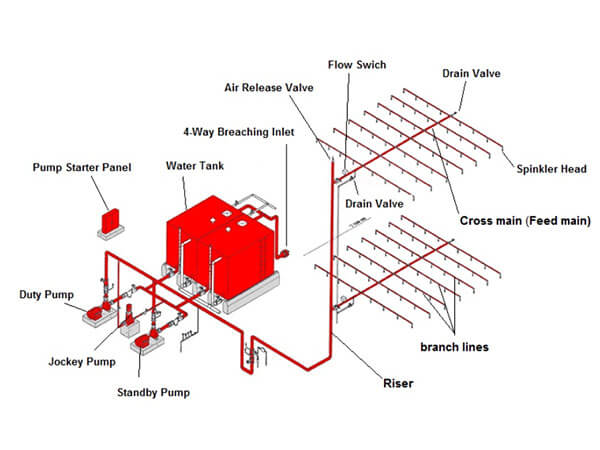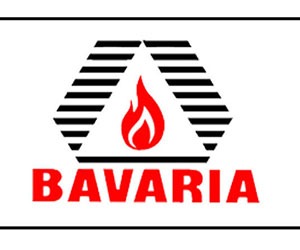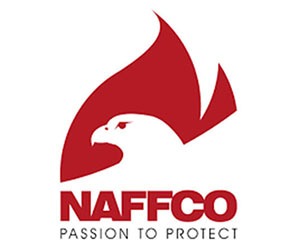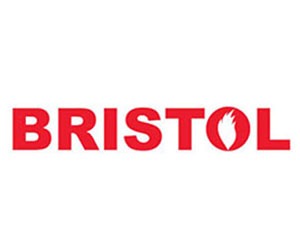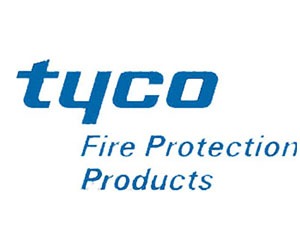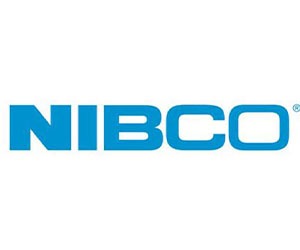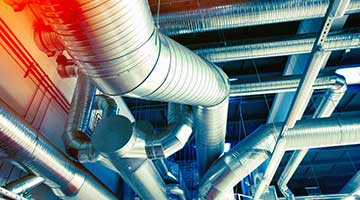Fire Fighting Systems
In the recent period, the world’s interest in Fire Fighting and developing systems has increased .. There is no building or factory in which these systems are not working, but it is unfortunate that these systems do not exist in abundance in Egypt as 90 percent of homes do not have fire Alarm or Fire Fighting systems .
It is necessary to know that all of these systems are designed by the technical support department in addition to many other systems such as lighting, telephones, surveillance cameras, fire alarms, anti-theft systems, wireless, audio systems and others
Important note: There is a link and connection between the fire alarm systems and the fire fighting system in order to quickly fight the fire and save the lives of citizens.
Types of Fire Fighting Systems:
this type is one of the most used types … for its cheap price and ease of installation
Fire fighting system installation explanation:
-
- Water Sprinkler: It is installed in the roof of the building .. and it is distributed so that the distance between each two pieces is about 2 meters or 3 meters and looks like a faucet, but it has a glass stopper that is easy to lot and contains a small amount of mercury .. And when a fire occurs it is heated Mercury and pressure on the glass stopper, it breaks, and the water falls on the fire to extinguish it.
- Fire Pump: A pump responsible for pumping water with high pressure on the fire so that it is extinguished more effectively.
- Fire Water Tank: It contains water and is connected to the pipes of the fire extinguishing pump to take water from it.
- Jockey Pump (Equalizing pressure pump): When combustion occurs and water begins to descend … the pressure inside the pipes decreases despite the presence of a fire pump and here comes the function of the jockey pump to equalize the pressure.
Carbon dioxide is used as a substitute for water in the case of that there are electrical devices or important papers or what like that in the room to be protected because of the water will damage these devices or papers. However, this gas is not used in rooms where there are people, because it is a toxic gas.
The cost of this type is of course more than the first type.
This type is used when there are electrical devices or papers that may be damaged by water .. and also the presence of people in the room .. because it is a non-toxic gas.
This type is effective and very good, but very expensive.
Foam gas is completely inert gas and it is impossible to react with any substance under normal conditions
Therefore, it must be used when there are Chemicals Material in the room to be protected (where the use of any of the three previous types will lead to a disaster if it interacts with these Chemicals Material).
This type is one of the most expensive and is used only when chemicals are present.
The Degrees of Hazard can be divided into:
The Hazard degree is divided into three parts according to the type of flammable materials present in the facility
1- Light Hazard
A light degree of Severity, such as papers, plastic and wood.
Churches – clubs – lecture halls – hospitals – libraries except for the huge stores in them – museums – offices – restaurants – theaters
2-Ordinary Hazard
It is divided into two groups according to the severity
Group A:
And it is liable to occur in the following places
parking lots – bakeries – food industries – electronic stations – glass industries – laundries – catering services.
Group B:
And it is liable to happen in the following places
Chemical laboratories – dry cleaning – horse stables – workshops – large libraries – metal industries – paper industries – post offices – theaters – repair garages – tire manufacturing – woodworking machines
3-Extra Hazard
Divided into two groups of dangerous
Extra group 1:
And it is liable to happen in the following places
Combustible hydraulic oils – foundries – plates – printing presses that use inks have a flash point of less than 37.8 degrees – rubber – cotton industries
Extra Group 2:
And it is liable to happen in the following places
compressed gas industries – oils – detergents – polishes – paints – prepared industries for asphalt
To design any water fire system, one must know and calculate the following:
1-Number of Fire Sprinklers
2-Distance between Fire Sprinklers
3-Galon per Minute GPM (Amount of water needed and flow rate).
4-Required Head.
5-Water tank (The size of the water tank)
6-Size of Pipe(The size of pipes to transport water to extinguish the fire)
The number of sprinklers used and the distance between them are determined according to the degree of danger (the speed of the spread of flame or fire), so the higher the degree of danger, the less the distance between the sprinklers.
Pump Selection
When choosing a pump, it is necessary to add the flow rate of water to the fire taps, which is 250 GBM and test whether or not the pressure given by the pump will give the pressure 4.5 bar at the faucet?
In the event that there is more than one Riser inside the building, 250 GBM is added to each Riser, with a maximum of 1250 GBM. Even if the number of Risers in the building increases, the maximum flow of the pump water is 1250 GBM, so as not to increase the size of the pump we want.
It is installed on the main line coming out of the tank and is called( The Header 3 ):
1-Electrical Pump .
2-Diesel Pump .
3-Jockey Pump .
The benefit of the Electric Pump is to give and distribute the pressure to the fire network,
The Diesel Pump is used to replace the first pump in case of a power outage or in case of an overload on the electric pump.
In the event of a leakage from the network at the connections, this may lead to a leakage of 10: 15 gpm. To compensate for this shortage leakage in the fire fighting network and the low pressure in it that may lead to the pump burnout, we install what is called a Jockey Pump to compensate for this deficiency and to maintain the large pump.
If the net pressure is 245 psi, we make the jockey run at 240 psi and the big pump at 230 psi.
The Jockey Pump is a centrifugal multi-stage pump that gives 15 gpm and head = 30 ft.
Therefore, it is vertical and has a height from 50 cm to 80 cm.
Often the jockey is a split case pump which is made of two halves connected to each other by screws and it gives a high Head & gpm.
Installation and connection of fire pumps:
- When installing the pump, it should be as close as possible to the header so that cavitation does not occur
- The plaster should be down to the entrance of the pump and not ride to the top.
- Before and after the pump, we install the following:
• Check Valve: to prevent water from returning again.
• Gate Valve: To shut down the network.
• Flexible Connection: to prevent the vibrations occurs because of the pump from reaching the pipes.
• Strainer: it is a filter to prevent dust from entering, and it is preferable not to install it.
• Flow Meter: to measure the amount of gpm. - The pump is installed on the Insulator with a rubber base or installed on its zip to prevent the transmission of vibrations to the building, pipes and tank.
- If the fire pipes are less than 2 inches, we install screws, but if the pipes are larger than 2 inches, then we install welding.
Conditions that must be met in fire pumps approved by the Civil Defense:
1- The pumps should be given the required Q and the H.
2- When choosing the pumps, they must be in the middle part of the curve to give the greatest efficiency.
3- When increasing the Q by 150%, the H must not be less than 65% of its original value.
4- Shut down pressure not more than 140% .
5- The pump must have UL,FM 6 FM & UL test certification.
6- It may be allowed to create a net positive suction head of no more than 10 to 20 psi.
7- The pumps used have capacities from 25 to 5000 gpm.

